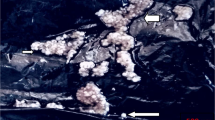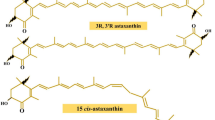Abstract
Research on antioxidant biomarkers can generate profound insights into the defense mechanisms of fish larvae against different stressors and can reveal manipulation strategies for improved growth and survival. However, the number of samples to process and unavailability of required infrastructure in larval-rearing facilities limit the immediate processing, requiring the preservation of specimens. Silver pompano (Trachinotus blochii), a potential marine aquaculture species, shows a low larval survival rate due to poorly developed antioxidant mechanism. In this context, 39 storage conditions, including three storage temperatures and different buffers, were scrutinized to select the most suitable preservation strategy for five important antioxidant biomarkers of fish larvae, viz. catalase activity, superoxide dismutase (SOD) activity, measurement of lipid peroxidation, reduced glutathione (GSH), and ascorbic acid contents. The paper proposes the optimum larval storage conditions for these five evaluated antioxidant biomarkers to generate similar results in preserved and non-preserved larval samples. Larval samples preserved in PBS at lower temperatures (− 20 °C and − 80 °C) are recommended for evaluating catalase activity and ascorbic acid content. Catalase activity can also be evaluated by preserving the larval samples at − 20 °C or − 80 °C without buffers. Larval samples held in PBS or without any buffers at − 20 °C and at − 80 °C were found to be suitable for SOD and GSH evaluation, respectively. Preservation in 50% glacial acetic acid at − 80 °C or − 20 °C was preferred for the lipid peroxidation assays. Apart from methodological perspectives, the paper provides insights into the dynamics of larval antioxidant profiles of T. blochii, for the first time.
Graphical Abstract





Similar content being viewed by others
Data availability
Data will be made available on request.
References
Abdul Nazar AK, Jayakumar R, Tamilmani G et al (2012) Larviculture and seed production of the silver pompano, Trachinotus blochii (Lacepede, 1801) for the first time in India. Indian J Fish 59:83–87
Aceto A, Amicarelli F, Sacchetta P et al (1994) Developmental aspects of detoxifying enzymes in fish (Salmo iridaeus). Free Radic Res 21:285–294. https://doi.org/10.3109/10715769409056581
Anchordoquy TJ, Carpenter JF (1996) Polymers protect lactate dehydrogenase during freeze-drying by inhibiting dissociation in the frozen state. Arch Biochem Biophys 332:231–238. https://doi.org/10.1006/abbi.1996.0337
Anil M, Ambarish PG, Surya S, Gomathi P, Santhosh B, Swathilekshmi PS, Joseph S, Raju B, Praveen P, Krishnapriya PM, Shalini O, Anand V, Gopalakrishnan A (2021) National broodbank serving the marine finfishfarming sector of india of pompano. Aquacult Spect 4(9):29–42
Beauchamp C, Fridovich I (1971) Superoxide dismutase: improved assays and an assay applicable to acrylamide gels. Anal Biochem 44:276–287. https://doi.org/10.1016/0003-2697(71)90370-8
Charan AA, Charan AI, Verma OP, Naushad SS (2015) Profiling of antioxidant enzymes in cat fish (Clarias batrachus) exposed to phenolic compounds. Asian J Bio Sci 10:6–14. https://doi.org/10.15740/HAS/AJBS/10.1/6-14
Chatdarong K, Chaivechakarn A, Thuwanut P, Ponglowhapan S (2012) Effects of cold storage prior to freezing on superoxide dismutase, glutathione peroxidase activities, level of total reactive oxygen species and sperm quality in dogs. Reprod Domest Anim 47:274–277. https://doi.org/10.1111/rda.12009
De Leon JAD, Borges CR (2020) Evaluation of oxidative stress in biological samples using the thiobarbituric acid reactive substances assay. J Vis Exp. https://doi.org/10.3791/61122
Ehrlich K (1972) Morphometrical, behavioural and chemical changes during growth and starvation of herring and plaice larvae. https://dspace.stir.ac.uk/bitstream/1893/30928/1/13917073.pdf. Accessed 21 May 2023
Galani JHY, Patel JS, Patel NJ, Talati JG (2017) Storage of fruits and vegetables in refrigerator increases their phenolic acids but decreases the total phenolics, anthocyanins and vitamin C with subsequent loss of their antioxidant capacity. Antioxidants 6:59. https://doi.org/10.3390/antiox6030059
Hadwan MH (2016) New method for assessment of serum catalase activity. Indian J Sci Technol 9:. https://doi.org/10.17485/ijst/2016/v9i4/80499
Hammer Ø, Harper DAT, Ryan and PD (2001) PAST: Paleontological Statistics Software Package for education and data analysis. Palaeontol Electron 4. http://palaeo-electronica.orghttp//palaeo-electronica.org/2001_1/past/issue1_01.htm
Hartmann J, Asch F (2019) Extraction, storage duration, and storage temperature affect the activity of ascorbate peroxidase, glutathione reductase, and superoxide dismutase in rice tissue. Biology (basel) 8:70. https://doi.org/10.3390/biology8040070
Jagota SK, Dani HM (1982) A new colorimetric technique for the estimation of vitamin C using Folin phenol reagent. Anal Biochem 127:178–182. https://doi.org/10.1016/0003-2697(82)90162-2
Kalaimani N, Chakravarthy N, Shanmugham R et al (2008) Anti-oxidant status in embryonic, post-hatch and larval stages of Asian seabass (Lates calcarifer). Fish Physiol Biochem 34:151–158. https://doi.org/10.1007/s10695-007-9155-4
Kalra A (2017) Decoding the Bland-Altman plot: basic review. J Pract Cardiovasc Sci 3:36. https://doi.org/10.4103/jpcs.jpcs_11_17
Khalil M, Gad N, Ahmed N, Mostafa S (2017) Antioxidant defense system alternations in fish as a bio-indicator of environmental pollution. Egypt J Aquat Biol Fish 21:11–28. https://doi.org/10.21608/ejabf.2017.3536
Klein RD, Borges VD, Rosa CE et al (2017) Effects of increasing temperature on antioxidant defense system and oxidative stress parameters in the Antarctic fish Notothenia coriiceps and Notothenia rossii. J Therm Biol 68:110–118. https://doi.org/10.1016/j.jtherbio.2017.02.016
Klu MW, Addy BS, Oppong EE et al (2016) Effect of storage conditions on the stability of ascorbic acid in some formulations. Int J Appl Pharm 8:26–31. https://doi.org/10.22159/ijap.2016v8i4.14131
Kumari K, Khare A, Dange S (2014) The applicability of oxidative stress biomarkers in assessing chromium induced toxicity in the fish Labeo rohita. Biomed Res Int 2014:1–11. https://doi.org/10.1155/2014/782493
Kurien BT, Scofield RH (2003) Free radical mediated peroxidative damage in systemic lupus erythematosus. Life Sci 73:1655–1666. https://doi.org/10.1016/S0024-3205(03)00475-2
Lin S-K, Tsai S-M, Huang J-C et al (2020) Effects of storage time and temperature on the stability of glutathione in deproteinized blood sample. J Food Drug Anal 14:. https://doi.org/10.38212/2224-6614.2486
Mas-Bargues C, Escrivá C, Dromant M et al (2021) Lipid peroxidation as measured by chromatographic determination of malondialdehyde. Human plasma reference values in health and disease. Arch Biochem Biophys 709:108941. https://doi.org/10.1016/j.abb.2021.108941
McDonald AG, Boyce S, Tipton KF (2009) ExplorEnz: the primary source of the IUBMB enzyme list. Nucleic Acids Res 37:D593–D597. https://doi.org/10.1093/nar/gkn582
McLennan SV, Heffernan S, Wright L et al (1991) Changes in hepatic glutathione metabolism in diabetes. Diabetes 40:344–348. https://doi.org/10.2337/diab.40.3.344
Mourente G, Tocher DR, Diaz E et al (1999) Relationships between antioxidants, antioxidant enzyme activities and lipid peroxidation products during early development in Dentex dentex eggs and larvae. Aquaculture 179:309–324. https://doi.org/10.1016/S0044-8486(99)00167-2
Neethu BR, Reshma KJ, Sumithra TG et al (2021) Profiles of hemolymph antioxidant system in apparently healthy marine bivalve, Perna viridis (Linnaeus, 1758) residing in a normoxic coastal ecosystem. Estuar Coast Shelf Sci 262:107599. https://doi.org/10.1016/j.ecss.2021.107599
Ohkawa H, Ohishi N, Yagi K (1979) Assay for lipid peroxides in animal tissues by thiobarbituric acid reaction. Anal Biochem 95:351–358. https://doi.org/10.1016/0003-2697(79)90738-3
Percie du Sert N, Hurst V, Ahluwalia A et al (2020) The ARRIVE guidelines 2.0: Updated guidelines for reporting animal research. PLoS Biol 18:e3000410. https://doi.org/10.1371/journal.pbio.3000410
Peters LD, Livingstone DR (1996) Antioxidant enzyme activities in embryologic and early larval stages of turbot. J Fish Biol 49:986–997. https://doi.org/10.1111/j.1095-8649.1996.tb00095.x
Rahman I, Kode A, Biswas SK (2006) Assay for quantitative determination of glutathione and glutathione disulfide levels using enzymatic recycling method. Nat Protoc 1:3159–3165. https://doi.org/10.1038/nprot.2006.378
Roberts JC, Francetic DJ (1993) The importance of sample preparation and storage in glutathione analysis. Anal Biochem 211:183–187. https://doi.org/10.1006/abio.1993.1254
Rudneva II (1999) Antioxidant system of Black Sea animals in early development. Comp Biochem Physiol Part C Pharmacol Toxicol Endocrinol 122:265–271. https://doi.org/10.1016/S0742-8413(98)10121-4
Sinha AK (1972) Colorimetric assay of catalase. Anal Biochem 47:389–394. https://doi.org/10.1016/0003-2697(72)90132-7
Skjærven KH, Penglase S, Olsvik PA, Hamre K (2013) Redox regulation in Atlantic cod (Gadus morhua) embryos developing under normal and heat-stressed conditions. Free Radic Biol Med 57:29–38. https://doi.org/10.1016/j.freeradbiomed.2012.11.022
Solé M, Potrykus J, Fernández-Díaz C, Blasco J (2004) Variations on stress defences and metallothionein levels in the Senegal sole, Solea senegalensis, during early larval stages. Fish Physiol Biochem 30:57–66. https://doi.org/10.1007/s10695-004-6786-6
Tacon AGJ (2020) Trends in global aquaculture and aquafeed production: 2000–2017. Rev Fish Sci Aquac 28:43–56. https://doi.org/10.1080/23308249.2019.1649634
Tovar-Ramírez D, Mazurais D, Gatesoupe JF et al (2010) Dietary probiotic live yeast modulates antioxidant enzyme activities and gene expression of sea bass (Dicentrarchus labrax) larvae. Aquaculture 300:142–147. https://doi.org/10.1016/j.aquaculture.2009.12.015
Ulmer CZ, Koelmel JP, Jones CM et al (2021) A review of efforts to improve lipid stability during sample preparation and standardization efforts to ensure accuracy in the reporting of lipid measurements. Lipids 56:3–16. https://doi.org/10.1002/lipd.12263
Vadstein O, Attramadal KJK, Bakke I et al (2018) Managing the microbial community of marine fish larvae: a holistic perspective for larviculture. Front Microbiol 9:1820. https://doi.org/10.3389/fmicb.2018.01820
Wang G, Peng K, Hu J et al (2021) Evaluation of defatted Hermetia illucens larvae meal for Litopenaeus vannamei : effects on growth performance, nutrition retention, antioxidant and immune response, digestive enzyme activity and hepatic morphology. Aquac Nutr 27:986–997. https://doi.org/10.1111/anu.13240
Wijaya L, Alyemeni M, Ahmad P et al (2020) Ecotoxicological effects of ibuprofen on plant growth of Vigna unguiculata L. Plants 9:1473. https://doi.org/10.3390/plants9111473
Yadav S, Kumar R, Khare P, Tripathi M (2015) Oxidative stress biomarkers in the freshwater fish, Heteropneustes fossilis (bloch) exposed to sodium fluoride: antioxidant defense and role of ascorbic acid. Toxicol Int 22:71. https://doi.org/10.4103/0971-6580.172261
Zeb A, Ullah F (2016) A simple spectrophotometric method for the determination of thiobarbituric acid reactive substances in fried fast foods. J Anal Methods Chem 2016:1–5. https://doi.org/10.1155/2016/9412767
Acknowledgements
The authors are grateful to the the Director, ICAR-CMFRI, Kochi, Dr. Anil M. K., Principal Scientist, Vizhinjam Regional Centre of ICAR-CMFRI and the Head-in-Charge of Vizhinjam Regional Centre of ICAR-CMFRI for providing the research facilities. AJ acknowledges CSIR-UGC for the fellowship and CUSAT (Cochin University of Science and Technology, Cochin) for her PhD registration. This work was supported by the Department of Biotechnology, Government of India funded “Dr. E.G. Silas Centre of Excellence and Innovation (EGS—CoEI) in Marine Fish Microbiome and Nutrigenomics” (BT/AAQ/3/SP28267/2018). GS acknowledges Department of Biotechnology funded EGS-CoEI, and RP acknowledges ICAR funded “Network programme on assessment of antimicrobial resistance (AMR) in microorganisms associated with fisheries and aquaculture in India” for their research fellowship.
Funding
This work was supported by the Department of Biotechnology, Government of India funded “Dr. E.G. Silas Centre of Excellence and Innovation (EGS—CoEI) in Marine Fish Microbiome and Nutrigenomics” (BT/AAQ/3/SP28267/2018).
Author information
Authors and Affiliations
Contributions
AJ performed the experiments, analyzed the results, and drafted the manuscript. STG and SRK conceptualized the presented idea, supervised the findings, helped in the analysis, and provided critical feedback in drafting the manuscript. RP, GS, and DVR provided technical support in conducting and analyzing the results. APG and AMS performed pompano larval production and maintenance. SRK supervised the project and acquired financial support for the project leading to this publication.
Corresponding author
Ethics declarations
Competing interests
The authors declare no competing interests.
Ethics approval
The larval samplings and experiments were done as per the ARRIVE guidelines (Percie du Sert et al. 2020). The live larvae were handled according to the guidelines of U.K. Animals (Scientific Procedures) Act (1986) and EU Directive 2010/63/EU for animal experiments (2019). The procedures for the maintenance and experiments of fish larvae were approved by the ICAR-CMFRI, Kochi, India (BT/AAQ/3/SP28267/2018).
Consent for publication
The manuscript has been read and approved for publication by all listed authors.
Consent to participate
Not applicable.
Additional information
Publisher's Note
Springer Nature remains neutral with regard to jurisdictional claims in published maps and institutional affiliations.
Rights and permissions
Springer Nature or its licensor (e.g. a society or other partner) holds exclusive rights to this article under a publishing agreement with the author(s) or other rightsholder(s); author self-archiving of the accepted manuscript version of this article is solely governed by the terms of such publishing agreement and applicable law.
About this article
Cite this article
Jagannivasan, A., Gopakumar, S.T., Sharma S R, K. et al. Profiling the antioxidant biomarkers in marine fish larvae: a comparative assessment of different storage conditions to select the optimal strategy. Fish Physiol Biochem 50, 557–574 (2024). https://doi.org/10.1007/s10695-023-01290-6
Received:
Accepted:
Published:
Issue Date:
DOI: https://doi.org/10.1007/s10695-023-01290-6




